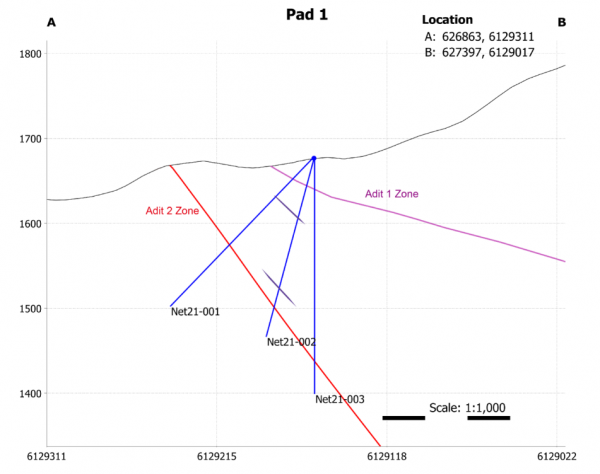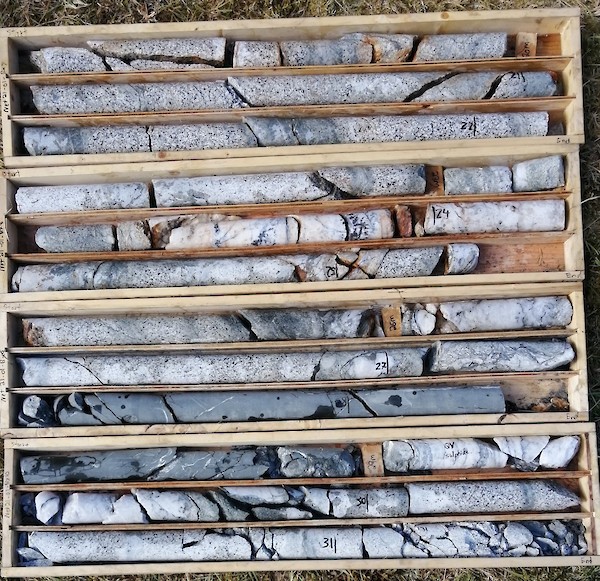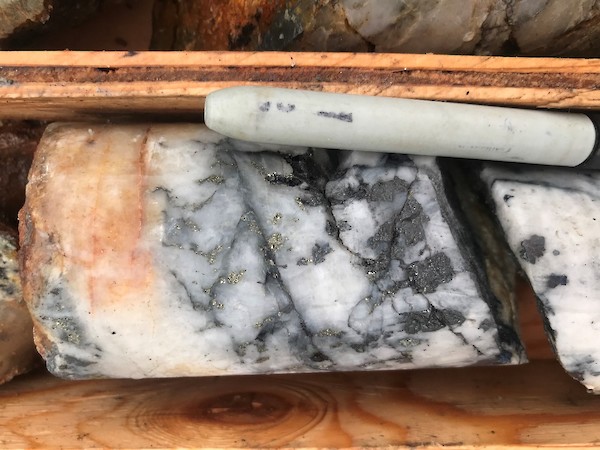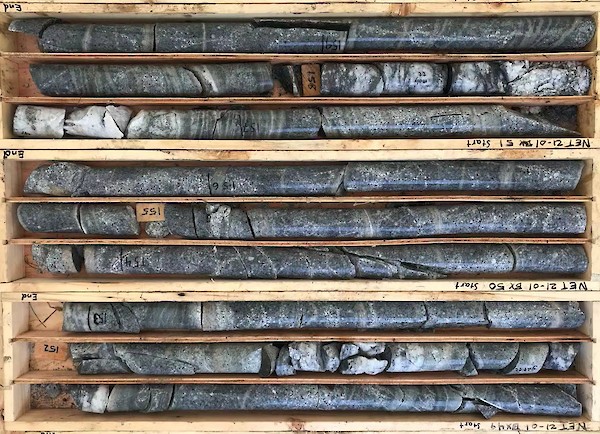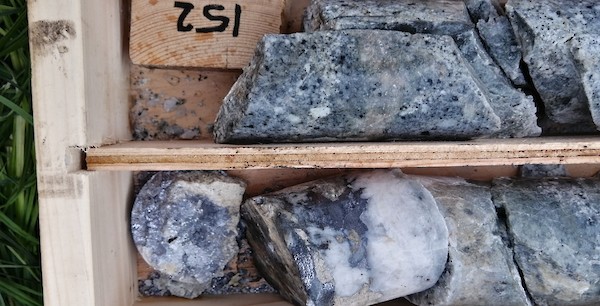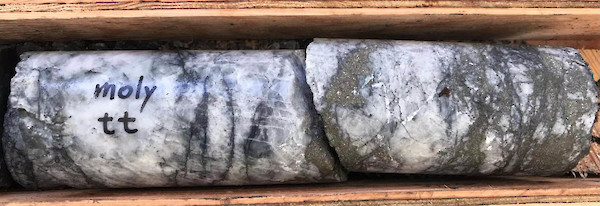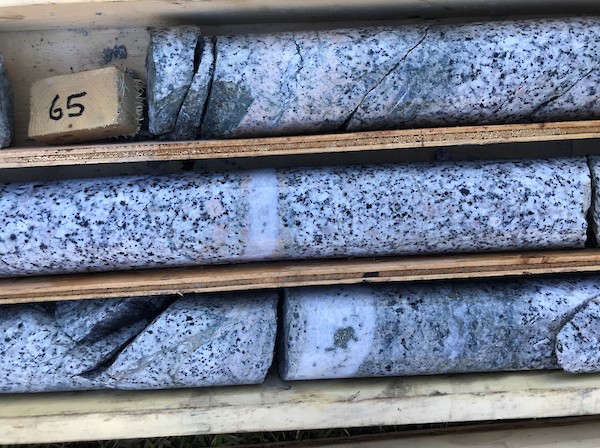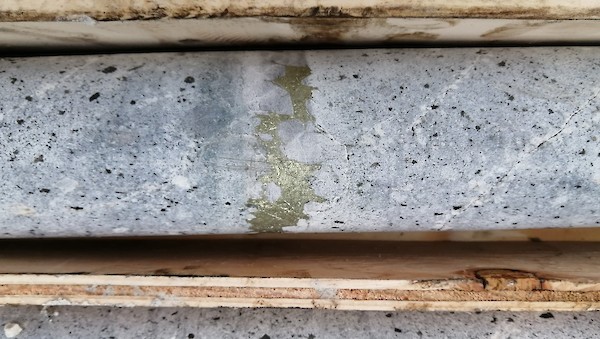Jaxon Advances Drilling Program At Netalzul Mt, Intersects Multiple Zones With High-Grade Silver Sulfide-Quartz Veins, Encounters Zones With Intense Potassic Propylitic Alteration, Vectors In On Deeper Porphyry Target
August 4, 2021, Vancouver, Canada - Jaxon Mining Inc. (“Jaxon” or the “Company”) (TSX.V: JAX, FSE: OU31, OTC: JXMNF) is pleased to announce it has completed its inaugural drill hole, NET21-01 (206 metres in length, 315°/-48°), at the Netalzul Mountain project on the Hazelton Property near Smithers, B.C. As designed, three holes (NET21-01, NET21-02 and NET21-03) will test for high-grade silver polymetallic sulfide-quartz veining zones at Daisy South Adit Zone, extending more than 1,600 metres (1.6 km) along the strike, and for patterns of alteration that indicate the presence of the deeper porphyry system that generated the mineralization (https://bit.ly/2TSGBqJ).
NET21-01 intercepted both Adit #1 and Adit #2 high-grade silver polymetallic sulfide-quartz veining zones as targeted, with total cuts of more than 23 metres in width (hole interception, not true width) of intense mineralized silver polymetallic sulfide-quartz veining zones (Figure 1). The Adit #1 veining zone previously reported Ag equivalent grades of up to 745 g/t for two metres, including Ag grades of up to 486 g/t, Au grades of up to 1.40 g/t and Cu grades of up to 1.40% from the 2020 channeling sampling program at surface (https://bit.ly/3yni6kF).
NET21-01 undercut the Adit #1 mineralization zone from 21.0 to 31.1 metres below surface at the Daisy South Adit Zone. The intense mineralized sulfide-quartz veining zone is present from 23.5 to 24.2 metres, 25.9 to 26.3 metres and 29.0 to 29.8 metres, respectively, with portable XRF (X-ray fluorescence) tests reporting high-grade tetrahedrite, sphalerite, galena, chalcopyrite, pyrite and molybdenite (Figure 2). It consists predominantly of quartz, abundant with different black materials. Based on portable XRF tests, four spot counts at 23.9 metres from NET21-01 returned over 4,000 g/t Ag, 6% Cu and 2.9% Sb, which are from tetrahedrite, and 6.6% Zn and 1.4% Pb, which are from sphalerite and galena (Figure 3, core at 23.9 metres from NET21-01).
The second mineralized sulfide-quartz veining zone reported up to 284 g/t silver equivalent (AgEq), including Ag grades of up to 186 g/t, Au grades of up to 0.7 g/t and Cu grades of up to 0.37% for five metres at surface in 2020 (https://bit.ly/3yni6kF). NET21-01 cut the second sulfide quartz veining zone from 147.9 to 162.0 metres below the Adit #2 surface mineralization, which includes multiple quartz veins and altered granodiorite with intense potassic alteration. The intense mineralized sulfide-quartz veining is present from 150.9 to 151.6 metres and 157.0 to 158.1 metres, respectively, with tetrahedrite, sphalerite, galena, chalcopyrite, pyrite and molybdenite (Figure 4). Spot counts with a portable XRF at 150.05 metres at NET21-01 returned over 222 g/t Ag, 49.95% Pb and 0.73% Zn, from 5 cm thick galena vein (Figure 5). Additional XRF spot counts at 157.9 metres returned over 97 g/t silver and 0.78% molybdenum (Figure 6).
Medium to strong potassic quartz veins or veinlets consisting of chlorite, muscovite, potassic feldspar and silica alterations with sulfides minerals including chalcopyrite, pyrite, molybdenite and chalcocite have been observed at both hanging wall and footwall country rock (granodiorite or diorite) at the Adit #1 and Adit #2 zones (Figures 2, 4 and 7). Some of these potassic quartz veins are rich with chalcopyrite and chalcocite (Figure 8). This type of potassic alteration can span from the beginning to the end of hole NET21-01, and can contain lower grade copper and molybdenum.
A second hole, NET21-02, drilled at the same pad as NETGD21-01 at Daisy South Adit Zone, with a 300 degree northeast orientation and -74 degree dip angle, intersected four different quartz veining and intense potassic alteration zones at 27 to 29 metres, 70.8 to 71.8 metres, 154 to 155.8 metres and 179.5 to 183.10 metres, respectively. Similarly, Adit #1 and Adit #2 quartz veining zones have been intercepted at hole NET21-02. Jaxon’s field crew is working on the detailed logging at the NET21-02 hole. The third vertical hole, NET21-03, is currently being drilled at the same pad as NETGD21-01 and NET21-02, to a depth of approximately 340 metres, to test both Adit #1 and Adit #2 mineralization zones at depth and to also test the potential porphyry-type alteration features at depth.
John King Burns, Chairman and CEO, commented, “With the results from these first drill holes, we are on track to publish, in Q1 of 2022, a model of an inferred, nearer to surface, polymetallic resource at Netalzul Mt. Further, we have been able to observe the types of alteration consistent with a deeper porphyry (source) system as visualized in our conceptual geological models. The deeper porphyry target modeled by Jaxon’s geological team has been confirmed by the comparative models in the Fathom Geophysics Study (as previously published). Fathom Geophysics’ model locates the porphyry system at depths between 800 and 1,000 metres. We will refine that vectoring with the data we collect from the examination of the well bores and drill core, and other geophysical work programs.”
Figure 1. Three diamond drill holes will test Daisy South Adit Zone to a depth of 23 to 3500 metres from surface at Pad 1.
Figure 2. Intense sulfide-quartz veining with tetrahedrite, sphalerite, galena, chalcopyrite, pyrite and molybdenite from 21.0 to 31.1 metres below surface.
Figure 3. Core at 23.9 metres from NET21-01 shows high-grade Ag-Cu-Sb-Pb-Zn. A portable XRF analyzer reported Ag grades of up to 20,000 g/t from the tetrahedrite mineral.
Figure 4. Intense sulfide-quartz veining with tetrahedrite, sphalerite, galena, chalcopyrite, pyrite and molybdenite from 150.9 to 158.1 metres below surface.
Figure 5. Core at 151.9 metres from NET21-01 shows high-grade Pb-Ag-Cu. A portable XRF analyzer reported lead grades of up to 49.9% from the galena vein.
Figure 6. Core at 157.9 metres from NET21-01 shows high-grade Mo-Ag-Cu. A portable XRF analyzer reported molybdenum grades of up to 0.78%.
Figure 7. Strong propylitic alteration consisting of chlorite, chalcopyrite, pyrite, potassic feldspar and quartz from 65-67 metres at hole NET21-01.
Figure 8. Massive chalcopyrite quartz vein at 193 metres at hole NET21-01.
Qualified Person
Yingting (Tony) Guo, P.Geo., President and Chief Geologist of Jaxon Mining Inc., a Qualified Person as defined by National Instrument 43-101, has reviewed and prepared the scientific and technical information and verified the data supporting such scientific and technical information contained in this news release.
About Jaxon Mining Inc.
Jaxon Mining is a Canadian-based exploration and development company pursuing the discoveries of commercial scale and grade Cu, Au, Ag, polymetallic projects. Jaxon focuses on overlooked and underexplored targets with deeper intervals that have not been identified or adequately explored; in areas that often have not been systematically mapped, modeled or drilled. Jaxon is currently focused on the Skeena Arch, an exceptionally orogenic and metallogenic area, in one of the most richly endowed terrains in British Columbia. The Company is preparing its 2021 drilling program to test the Netalzul Mountain and Red Springs projects on its 100% controlled Hazelton property.
ON BEHALF OF THE BOARD OF DIRECTORS
JAXON MINING INC.
“John King Burns”
John King Burns, Chairman
For more information please contact:
Investor Relations
Kaye Wynn Consulting
T: 604-558-2630
TF: 1-888-280-8128
E: info@kayewynn.com
Freeform Communications
T: 604-243-0499
E: enquiries@freeform.com
Corporate
T: 604-424-4488
E: info@jaxonmining.com
This news release may contain forward-looking information, which is not comprised of historical facts. Forward-looking information involves risks, uncertainties and other factors that could cause actual events, results, performance, prospects and opportunities to differ materially from those expressed or implied by such forward-looking information. Forward-looking information in this news release may include, but is not limited to, the Company's objectives, goals or future plans. Factors that could cause actual results to differ materially from such forward-looking information include, but are not limited to, those risks set out in the Company's public documents filed on SEDAR. Although the Company believes that the assumptions and factors used in preparing the forward-looking information in this news release are reasonable, undue reliance should not be placed on such information, which only applies as of the date of this news release, and no assurance can be given that such events will occur in the disclosed time frames, or at all. The Company disclaims any intention or obligation to update or revise any forward-looking information, whether as a result of new information, future events or otherwise, other than as required by law. Neither TSX Venture exchange nor its Regulations Services Provider (as that term is defined in the policies of the TSX Venture Exchange) accepts responsibility for the adequacy or accuracy of this release.

